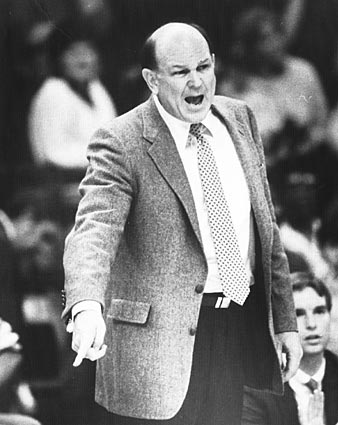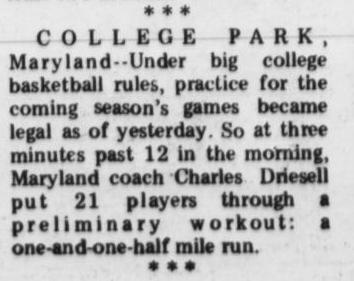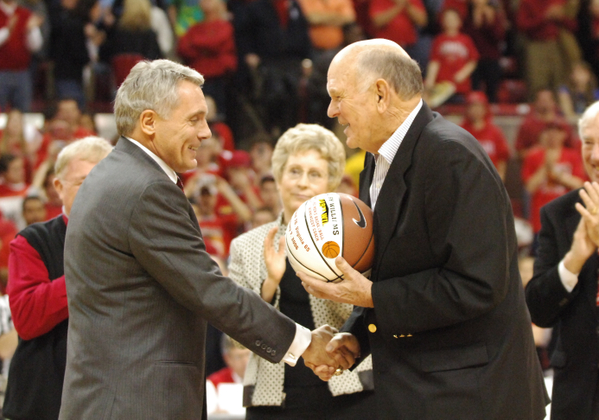The RTC Interview Series: One On One With Lefty Driesell
Posted by nvr1983 on October 14th, 2010Rush The Court is back with another edition of One on One: An Interview Series, which we will bring you periodically throughout the year. If you have any specific interview requests or want us to interview you, shoot us an email at rushthecourt@yahoo.com.
Few college coaches have had careers with as much success at as many different venues as Charles “Lefty” Driesell. After playing at Duke under Harold Bradley, he coached a few years of high school basketball in Virginia finishing with a 57-game winning streak at Newport News High School before accepting a head coaching position at Davidson where he coached for nine seasons compiling a 176-75 record leading the Wildcats from the bottom of the Southern Conference to the Elite Eight in back-to-back seasons (yes there was basketball at Davidson before Stephen Curry). Following the 1969 season, Driesell moved to Maryland, which is where most basketball fans associate him with. After a rough start his first two years in College Park where his teams went a combined 27-25 (10-18 in the ACC), Driesell quickly turned things around making it to the NCAA Elite Eight twice more and winning the NIT in a span of four seasons at a time when only the ACC Tournament champion was awarded a bid to the NCAA Tournament. This hit the Terrapins especially hard in 1974 when they were a top five team who lost what many consider to be one of the greatest college games of all-time, a 103-100 loss in overtime to David Thompson and eventual national champion North Carolina State. It was just prior to the start of that run in 1971 that Driesell instituted what would come to be viewed as the predecessor of Midnight Madness when he gathered his team a few minutes after midnight on the first day of practice for a training run around the track. In the subsequent 39 years, the tradition has transformed from a humble event into a media spectacle. Following that four-year run, Driesell’s most notable success came in the mid-1980s when the Terrapins re-emerged in the national consciousness with the play of Len Bias and his subsequent passing just after he was drafted by the Boston Celtics. After leaving Maryland in the wake of the Bias scandal, Driesell was away from the sidelines for two years before returning to coach at James Madison and later Georgia State, making the NCAA Tournament three more times including a 2001 win at GSU over Wisconsin in the first round of the NCAA Tournament. For his contributions to the game, Driesell was inducted into the University of Maryland Athletic Hall of Fame in 2002 and the National Collegiate Basketball Hall of Fame in 2008. Earlier this week we caught up with him to discuss the origins of Midnight Madness and other issues relating to the current state of college basketball.
RTC: You started “Midnight Madness” in 1971 based on a 1.5 mile run, which it seems like you continued all the way through your Georgia State days. Could you talk a little bit about your motivation for coming up with the idea and what your thoughts are on what it has become today?
LD: My thought at the time was to make sure that the guys, when practice started on October the 15th [were ready]. We didn’t have all this conditioning and weightlifting like they have now. Until October the 15th you couldn’t have anything to do with the players. Right now they start conditioning with four hours per week for team practice or something. You know what I’m saying. Back then you couldn’t do anything until October the 15th. You couldn’t hold meetings. You couldn’t lift weights with them. You couldn’t run or condition them. It was a way for me to encourage them to get in shape for October the 15th when practice started. I always ran them a mile on October the 15th. That kind of messed up my practice on that day. So George Raveling and I were talking and we said why don’t we just run the mile at 12:01 and then we can practice at 3 o’clock that afternoon. So that’s what we did for the first year. You know we had cars on the track with lights on so nobody would cut the course, but I heard that [Len] Elmore did. So I don’t know if we did that one year or two years, but Mo Howard said, “Hey Coach. Why don’t we just have a scrimmage at midnight next year?” because they wanted to get out of the running. So I said, “Yeah. Alright we can do that.” So we did the next year. We had a scrimmage and had seven or eight thousand kids. . . In fact we had a lot of kids watching us run that night [in 1971]. It was like my second year at Maryland. We were going to have a good team. We had [Tom] McMillen and Elmore coming up as sophomores. We had our undefeated freshman team the year before so everybody was excited. We had a lot of people just watching us run that first year so Mo said “Let’s have a scrimmage at midnight next year” so we did and we had about ten thousand people show up and from then on we filled it up. So that was kind of the way we got it started. It let us get a jump on everybody. I told them we’re going to practice before anybody else in the country and we’re going to be playing on the last day in the NCAA Finals. You know just a little motivational thing.
RTC: Could you talk a little bit about its evolution and what it has become now? It’s on ESPN, ESPN2, ESPNU, all of the ESPNs, and a lot of other channels. What are your thoughts on that?
LD: I think it’s great. It has helped promote basketball. It gets the students and the fans thinking basketball in the middle of football and baseball and everything. I think it’s great. The only thing that I don’t like is that they let them have it at 5 o’clock in the afternoon instead of midnight. I think midnight created more interest because kids like to stay up late. I think one of the best teams I ever had was at James Madison and we played a game at midnight. I see that a couple teams play games at midnight this year. I think that’s great because college kids like to stay up late when they should be in bed. At least they are better off at a basketball game than somewhere else. I wish it was still at midnight. A lot of people call it “Basketball Madness,” but it really is “Midnight Madness.”
RTC: As you have stated you have been at quite a few schools. Do you have any particular allegiance to one school? What happens when two of your former schools play against each other?
LD: Well I played at Duke. (Laughs) You mean right now? I kind of root for everywhere I coached. I don’t get that involved. You know my son [Chuck Driesell] is coaching at The Citadel. He is the head coach. He just got the job this spring. So naturally I’ll be rooting for them. In fact I’m getting ready to go down there to watch his first practice on Friday, but he can’t have it at midnight. He’s going to have it at 5 o’clock. (Laughs)
RTC: Now for some general questions about college basketball. What do you think about the current state of recruiting with all the allegations that are flying around now about different major programs and how the impact of the one-and-done player has changed that?
LD: I just sent an article to Sports Illustrated on September 27th for their “Talking Point” or whatever the name of it was saying that forfeiting games does no good, that you should fine them. I totally disagree with that. I’ve been trying to emphasize forfeiting games for years because you pay money…what does that mean? If you punish a coach or school with forfeiting games that illegal players played…every high school association in America does that. You play an ineligible player, you lose the games that player played in. If you play a kid that has been illegally recruited or taken money from an agent or something, forfeit all the games he played. That’s the best punishment you can give a player or a coach. Then I agree to go ahead and fine them, too. I think if you want to curtail cheating then you forfeit games that players played in that were illegally recruited.
RTC: So you want what happened with the 2008 Memphis team or the Fab Five Michigan teams with Chris Webber…is that the punishment that you are in favor of?
LD: Oh yeah. I forgot. What did they forfeit? Yeah. I’m in favor of forfeiting.
RTC: The Fab Five had to forfeit their Final Fours including championship games in 1992 and 1993.
LD: Why did they have to forfeit them?
RTC: Webber had reportedly taken over $200,000 from a booster.
LD: Well they should have forfeited every game that he played in.
RTC: That’s what they did. They had to take down the banners from Crisler Arena too. [Ed. Note: Although Michigan originally forfeited all of those games they later decided to vacate a large majority of those games (see page 56 or “Sec19:56” of the official NCAA Division I records for more details). They did take down the banners too.]
LD: I think that’s good.
RTC: One last general NCAA question. What are your thoughts on the expansion of the NCAA Tournament, particularly with reference to the 1974 ACC Finals when you suffered one of the most difficult defeats in NCAA history at the hands of NC State? What do you think about how they have expanded first to 32 then to 64 then 65 and now 68? What are your thoughts on this continued expansion?
LD: Well I think they should let everybody in. That’s my opinion because then people would play better schedules. I was just looking at some ACC teams’ schedules that just came out. Some of them have got nine guaranteed games, and six, and five. They do that so the NCAA Selection Committee will let them in. When I first started coaching you played everybody home-and-home. I played Duke home-and-home. I played everybody I could play when I was at Davidson home-and-home. That was the fair thing to do. I’m going to play on your court then you come back and play me on my court or I’m not going to play. These guaranteed games started when I was at Georgia State and JMU. I never played a guaranteed game. Coaches would call me up and say, “Hey Coach. I’ll give you $80,000 to come here and play us a game.” I’d say “Fine. Let me tell you what. I’ll pay you $100,000 to come play me in Atlanta,” which I couldn’t do, but I knew that they wouldn’t do it. They would go “(mumbling) Oh, no. We’re not going to do that!” so I’d go, “Well play us home-and-home”. They would say, “We’re not going to do that.” I think those guaranteed games for football like this year Alabama is playing Georgia State in football and Georgia State is in the first year they have ever had because [Alabama] is giving them $700,000. Well, that’s not right. Let them come back and play Georgia State in the Georgia Dome next year and they could fill it up with 70,000 people. It’s wrong, and it’s wrong in basketball too. When I was at Georgia State I played one guaranteed game against a Division II team, but I didn’t give them $100,000. I gave them like $2,000 so they would come in there. At the end of the year, say my record was 20-10. Well, actually for the NCAA Selection Committee, my record was 19-10. It didn’t count [the game against the Division II team]. I think the NCAA shouldn’t count guaranteed games when it comes time to pick teams for the NCAA [Tournament] and that way everybody should be made to play home-and-home. This guaranteed stuff irritates the heck out of me because it’s not fair. If I’m going to play you on your home court you should play me on my home court because I’m going to beat you on my home court. The NCAA ought to say no guaranteed games. Schools make more money off a guaranteed game than they do off of a conference game because the students don’t come and some of the season ticket holders don’t come then they sell those tickets so they are racking up the money, but they aren’t helping the teams that are going there to play. If Alabama had to play Georgia State at Georgia State next year they would sell 70,000 tickets and they would make some big money. Then they might have a better chance of beating them. They don’t have a chance of beating them this year at Alabama. I’m not talking about just football. It’s even worse in basketball because they play a whole bunch of them. Most all schools play five or six. Some of them play nine. I saw one team playing nine of them this year so they got nine wins before they start.
RTC: One last question for you — and I realize this is a topic that you have talked quite a bit about in the past. Did you get a chance to watch the ESPN 30 for 30 piece “Without Bias” and if you did what were your thoughts on it?
LD: I thought it was pretty good. I thought it was all right. It brought out a point that I have always said that I don’t think that Lenny Bias used drugs regularly. I mean nobody on there (his girlfriend, his teammates, my son roomed with him) had ever seen him mess with drugs. I think that one night this guy who was supposed to be his friend brought some drugs in there and he [Bias] didn’t know what he was doing and it killed him. Len Bias was a great kid. He was a born-again Christian. He went to church every Sunday. You know he was a great basketball player and a great individual. He tried it that night. I don’t have any proof and if you look at that documentary nobody said he used it before except the guy that brought it in that night and he tried to cover his tracks.
















































Awesome interview… Just curious. How do you go about getting them? Do you just call them out of the blue? You get the number through the school?
Interested for sure, but either way-great work!
Thanks, BuckyBadger. We utilize our network of contacts to get our interviews, and with Driesell luckily we knew some people who know him.